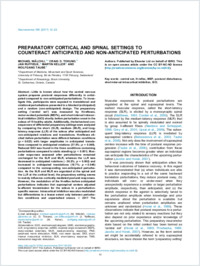Preparatory cortical and spinal settings to counteract anticipated and non-anticipated perturbations
- Wächli, Michael Department of Medicine, Movement and Sport Sciences, University of Fribourg, Switzerland
- Tokuno, Craig D. Department of Kinesiology, Brock University, St. Catharines, Ontario, Canada
- Ruffieux, Jan Department of Medicine, Movement and Sport Sciences, University of Fribourg, Switzerland
- Keller, Martin Department of Medicine, Movement and Sport Sciences, University of Fribourg, Switzerland
- Taube, Wolfgang Department of Medicine, Movement and Sport Sciences, University of Fribourg, Switzerland
-
04.12.2017
Published in:
- Neuroscience. - 2017, vol. 365, no. Supplement C, p. 12–22
English
Little is known about how the central nervous system prepares postural responses differently in anticipated compared to non-anticipated perturbations. To investigate this, participants were exposed to translational and rotational perturbations presented in a blocked (anticipated) and a random (non-anticipated) design. The preparatory setting (‘central set’) was measured by H-reflexes, motor-evoked potentials (MEPs), and short-interval intracortical inhibition (SICI) shortly before perturbation onset in the soleus of 15 healthy adults. Additionally, the behavioral consequences of differential preparatory settings were analyzed by comparing the short- (SLR), medium- (MLR), and long-latency response (LLR) of the soleus after anticipated and non-anticipated rotations and translations. H-reflexes elicited before perturbation were different between conditions (p=0.023) with larger amplitudes in anticipated translations compared to anticipated rotations (37.0%; p=0.048). Reduced SICI was found in the three conditions containing perturbations compared to static standing (p0.001). Muscular responses assessed after perturbations remained unchanged for the SLR and MLR, whereas the LLR was decreased in anticipated rotations (−36.2%; p=0.002) and increased in anticipated translations (16.7%; p=0.046) compared to the corresponding non-anticipated perturbation. As the SLR and MLR are organized at the spinal and the LLR at the cortical level, the preparatory setting seems to mainly influence cortically mediated postural responses. However, the modulation of the H- reflex before anticipated perturbations indicates that supraspinal centers adjusted Ia- afferent transmission for the soleus in a perturbation-specific manner. Intracortical inhibition was also modulated but differentiates to a lesser extent only between perturbation conditions and unperturbed stance.
- Faculty
- Faculté des sciences et de médecine
- Department
- Département de Médecine
- Language
-
- English
- Classification
- Biological sciences
- License
- License undefined
- Identifiers
-
- RERO DOC 306286
- DOI 10.1016/j.neuroscience.2017.09.032
- Persistent URL
- https://folia.unifr.ch/unifr/documents/306234
Statistics
Document views: 48
File downloads:
- tau_pcs.pdf: 135
